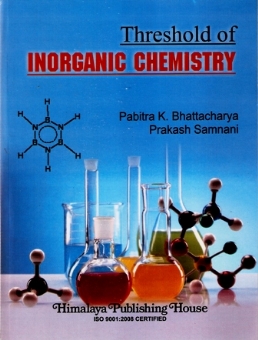Threshold of Inorganic Chemistry
no information available
As the title of the book suggests, this provides an access to the rich and interesting realm of Inorganic Chemistry. Inorganic Chemistry was misunderstood as a descriptive account of the methods of preparation and properties of elements to be committed to memory. But this book reveals the enormity of the subject of Inorganic chemistry. At one end, it incorporates the concepts of physics, such as quantum mechanics, Solid state and group theory, and at the other end, it extends to the area of biology and biochemistry, revealing the importance of metal ions in biochemical reactions. The first two chapters in the present an account of quantum theoretical and quantum mechanical concepts of the structure of the atom. The third chapter deals with the periodic table and the principles of periodicity of the elements. The fourth chapter deals with the electronic concept of valency and structure of the molecule. The fifth chapter introduces the concept of symmetry and consideration of a molecule as a point group. This concepts has been used in the sixth chapter dealing with the quantum mechanical approach to bonding and molecular structure. The Seventh chapter presents a detailed account of the solid state structure of non-metals, metals and ionic compounds. In the eighth chapter, all the aspects of the structure and properties of the complex compounds have been discussed. In the ninth, tenth and eleventh chapters, there is a comparative discussion of the structure, properties and compounds of the non-transition, transition and inner transition elements, in the background of atomic structure, bonding and the periodic table. There is also a brief account of general methods of obtaining the metals in pure state included in the chapter. The last chapter deals with the role of metal ions in various biochemical reactions. This book will provide a theoretical background to the understanding of Inorganic Chemistry. An attempt has been made to explain the physical meaning of the mathematical expressions, that appear in the quantum mechanical consideration of atomic and molecular structure. The book has mainly stressed the understanding of why and how of the observations, rather than listing the descriptive details. The book has included a set of objective questions at the end of each chapter, with hints for solution in some cases. Some of the topics dealt with in the book have been taught and developed stepwise in junior classes. It was necessary to mention about some of the basics, while dealing them in more advanced level in this book. It was felt essential, to be done, for clarity and to maintain the continuity. this should not be mistaken as a repetition. The book is mainly intended for B.Sc. students. However, it will be useful for the post graduate students to refresh their background for advanced studies. Contents - 1. Quantum Theory and Atomic Structure 2. Quantum Mechanical Model of Atom 3. Periodic Table 4. Electronic Concept of Chemical Bond 5. Molecular Symmetry and Point Group 6. Wave Mechanical Concept of Covalency 7. Structures of Solids 8. Complex Compounds 9. Comparative Study of Elements within the Groups of the Periodic Table 10. Occurrence of Transition and Non-transition Metals in Nature and their Extraction in Pure Metallic Form 11. Inner Transition Series 12. Role of Metal Ions in Biological Systems Bibliography ... Read more Read less











